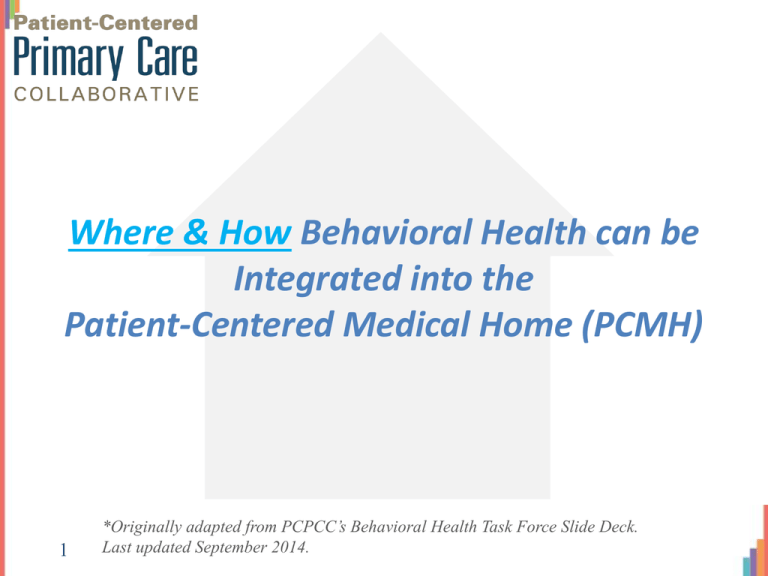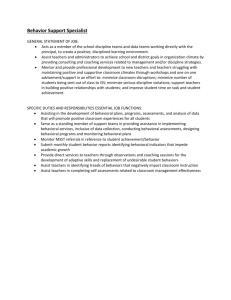
Where & How Behavioral Health can be
Integrated into the
Patient-Centered Medical Home (PCMH)
1
*Originally adapted from PCPCC’s Behavioral Health Task Force Slide Deck.
Last updated September 2014.
Purpose of Slide Deck
• To allow users to adapt these slides for your own
presentations. Please see the notes sections for more
detailed information.
• This slide deck is focused on the “where” and “how”
behavioral health is being integrated into the patientcentered medical home (PCMH).
• You may also pull slides from Deck 1 to learn about the
“why” behavioral health should be integrated into the PCMH.
2
PCPCC 2014. All Rights Reserved.
Slide Deck Outline
1. Where Integrated Behavioral Health Models are Happening
2. Models for Integrating Behavioral Health in the PCMH
– Coordinated Care Models
– Co-Located Models
– Integrated Models
3. Resources & Acknowledgements
3
PCPCC 2014. All Rights Reserved.
Where Integration is Happening
Source: AHRQ, The Academy Integration Map. Accessed September 2014.
http://integrationacademy.ahrq.gov/ahrq_map
4
PCPCC 2014. All Rights Reserved.
Models for Integrating Behavioral
Health in the PCMH
5
Integration: An Evolving Relationship
Consultative Model
• Psychiatrists sees patients in consultation in his/her
office – away from primary care
Co-located Model
• Psychiatrist sees patients in primary care
Collaborative Model
• Psychiatrist provides caseload consultation about primary
care patients; works closely with primary care providers
(PCPs) and other primary care-based behavioral health
providers (BHP)
6
Source: http://uwaims.org
PCPCC 2014. All Rights Reserved.
Based on Population Needs & Required Systems
Source: Mauer BJ (2004).
Behavioral Health / Primary Care
Integration: The Four Quadrant
Model and Evidence-Based
Practices. National Council for
Community Behavioral Health.
www.mcpphealthcare.com
7
PCPCC 2014. All Rights Reserved.
Collaborative Care
Collaborative care optimizes all behavioral health resources
8
Source: http://uwaims.org
PCPCC 2014. All Rights Reserved.
Relationship Between Medical & Behavioral Health
Services (Collaboration for Same-Day Access)
• Coordinated (shared costs) = Behavioral services by
referral at separate location via synchronous (realtime) or asynchronous (later) information exchange
• Co-Located (separate funding sources)= By referral
processes at primary care location (behavioral health
visit in referral office)
• Integrated (same funding resource) = At primary care
location (face to face with behavioral health team or
by virtual synchronized telemetry)
Source: Blount, A. (2003). Integrated primary care: Organizing the evidence.
Families, Systems & Health: 21, 121-134.
9
PCPCC 2014. All Rights Reserved.
Coordinated Care
• Coordinated care elements:
– Appointment arrival notification
– Clinical information exchange protocols
– Coordinated treatment planning and/or problem
solving for complex patients or as needed
• Expect communication to go both ways.
– Mental health clinicians are healthcare
professionals who should be knowledgeable about
the patient’s health issues.
• Ask about the person’s health behavior goals
and consider them in treatment planning.
10
PCPCC 2014. All Rights Reserved.
Coordination Plus – Specialty Mental
Health as a Consultant to Primary Care
• Massachusetts Child Psychiatry Access
Program
• For adults in NC, Medicaid pays for time of
primary care physician and psychiatrist as
patient visit rates (for consultation about a
patient) whether the psychiatrist has met the
patient or not.
• When behavioral health clinicians are working
in primary care, referrals to specialty care for
patients in need of longer-term work is more
likely to be successful.
11
Source: Center for Integrated Primary Care, UMass Medical School
PCPCC 2014. All Rights Reserved.
Co-Located Behavioral Health
(Helps Reduce Stigma!)
• Behavioral health in the same space with primary care
• Involvement by referral
• Separate behavioral health and medical treatment plans
Advantages
Challenges
• Access greatly improved
• Improved patient &
provider satisfaction
• Cost effective
• Improved clinical outcomes
• Referrals don’t show
• Case-loads fill up
• Slow primary care physician
learning curve
• Communication still difficult
12
Integrated Primary Care:
Behavioral Health Consultant
• Management of psychosocial aspects
of chronic and acute diseases
• Application of behavioral
principles to address lifestyle
and health risk issues
• Consultation and co-management in the treatment
of mental disorders and psychosocial issues
13
Source: Center for Integrated Primary Care, UMass Medical School
PCPCC 2014. All Rights Reserved.
Models of Integrated Behavioral Health
IMPACT/Diamond (Expanded
Care Management):
Disease based
Research heritage
Patient outcome evidence
Care manager (SW or Psychologist)
Behavioral Health Consultant:
Program based
Clinical heritage
Cost & satisfaction evidence
Behavioral health consultant
The models are beginning to converge:
Care manager does other
Behavioral health care management
behavioral health care and chronic and case managers added.
illness added.
Beginning disease programs.
Array of services beyond disease
programs.
14
Source: Center for Integrated Primary Care, UMass Medical School
PCPCC 2014. All Rights Reserved.
Integrated Primary Care:
The IMPACT Treatment Model
• Stepped protocol in primary care using antidepressant
medications and/or 6-8 sessions of psychotherapy (PST-PC)
– Treat to target
• Collaborative care model includes:
– Care manager: Depression Clinical Specialist
• Patient education
• Symptom and side effect tracking
• Brief, structured psychotherapy: PST-PC
– Consultation / weekly supervision meetings with
• Primary care physician
• Team psychiatrist
Source: Center for Integrated Primary Care, UMass Medical School
15
PCPCC 2014. All Rights Reserved.
Fully Integrated Primary Care
The System
Source: Center for Integrated Primary Care, UMass Medical School
16
Substantial Improvement in Depression
(≥50% Drop on SCL-20 Depression Score from Baseline)
Response (≥50% drop on SCL-20 depression score from baseline)
60
50
percent
40
30
20
10
0
3
6
12
month
Usual care
Intervention
Source: Center for Integrated Primary Care, UMass Medical School
17
PCPCC 2014. All Rights Reserved.
Resources & Acknowledgements
18
Selected Resources
•
•
•
•
•
•
•
•
AHRQ Academy for Integrating Behavioral Health and Primary Care:
http://integrationacademy.ahrq.gov/
AIMS CENTER: http://aims.uw.edu/
Center for Integrated Primary Care: http://www.umassmed.edu/cipc/
Collaborative Family Healthcare Association: www.cfha.net
Evolving Models of Behavioral Health Integration in primary Care.
Milbank Memorial Fund 2010. http://www.milbank.org
Lexicon for Behavioral Health and Primary Care Integration. AHRQ
2013: http://integrationacademy.ahrq.gov/sites/
default/files/Lexicon.pdf
National Alliance on Mental Illness. Integrating Mental Health &
Pediatric Primary Care Resource Center: http://www.nami.org
SAMHSA/HRSA Center for Integrated Health Solutions:
http://www.integration.samhsa.gov
19
PCPCC 2014. All Rights Reserved.
Case Studies & Videos
•
•
•
•
Case Study: Colorado’s Advancing Care Together.
http://www.advancingcaretogether.org/
Video: AIMS Center. Daniel’s Story: An Introduction to
Collaborative Care. http://aims.uw.edu/daniels-storyintroduction-collaborative-care
Webinars: University of Colorado’s Department of Family
Medicine Policy Channel.
http://www.youtube.com/CUDFMPolicyChannel
PCPCC Online Resource: Successful Examples of Integrated
Models. http://www.pcpcc.org/content/successful-examplesintegrated-models
20
PCPCC 2014. All Rights Reserved.
Acknowledgements
• Special thanks to:
– PCPCC’s Behavioral Health Group
– PCPCC’s Behavioral Health Advisory Team
•
•
•
•
•
•
Alexander Blount, EdD, University of Massachusetts
Parinda Khatri, PhD, Cherokee Health Systems
Benjamin Miller, PsyD, University of Colorado
George Patrin, MD, Serendipity Alliance
CJ Peek, PhD, University of Minnesota
David Pollack, MD, Oregon Health & Science University
– Erik Vanderlip, MD, University of Oklahoma
21
*Originally adapted from PCPCC’s Behavioral Health Task Force Slide Deck.
Last updated September 2014.
PCPCC 2014. All Rights Reserved.







